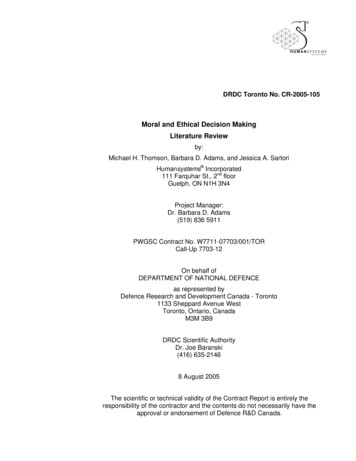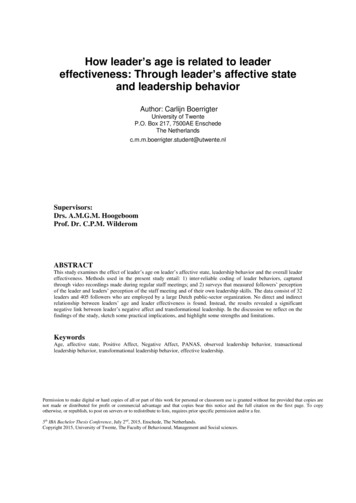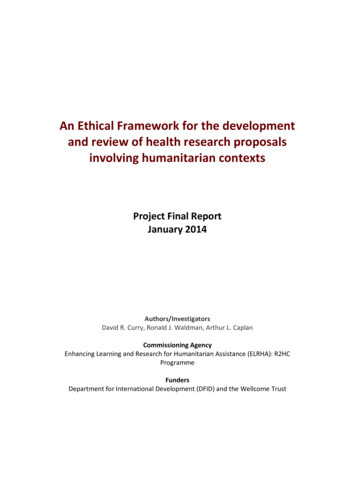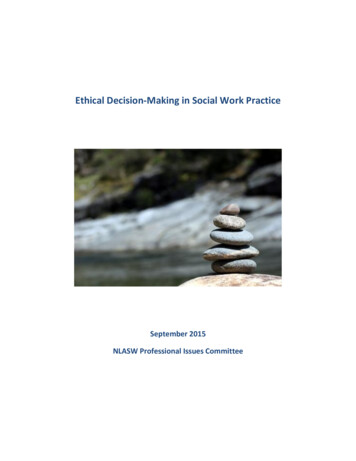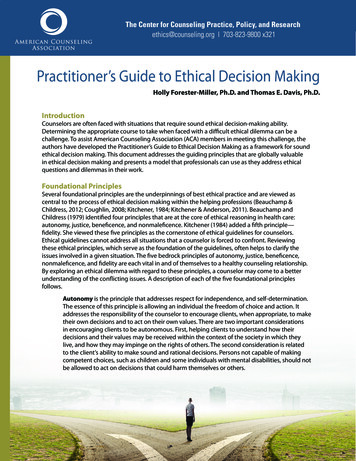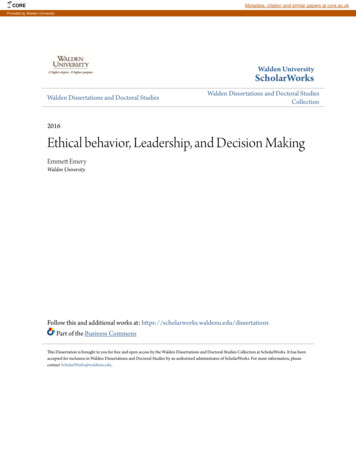
Transcription
COREMetadata, citation and similar papers at core.ac.ukProvided by Walden UniversityWalden UniversityScholarWorksWalden Dissertations and Doctoral StudiesWalden Dissertations and Doctoral StudiesCollection2016Ethical behavior, Leadership, and Decision MakingEmmett EmeryWalden UniversityFollow this and additional works at: https://scholarworks.waldenu.edu/dissertationsPart of the Business CommonsThis Dissertation is brought to you for free and open access by the Walden Dissertations and Doctoral Studies Collection at ScholarWorks. It has beenaccepted for inclusion in Walden Dissertations and Doctoral Studies by an authorized administrator of ScholarWorks. For more information, pleasecontact ScholarWorks@waldenu.edu.
Walden UniversityCollege of Management and TechnologyThis is to certify that the doctoral study byEmmett Emeryhas been found to be complete and satisfactory in all respects,and that any and all revisions required bythe review committee have been made.Review CommitteeDr. Janet Booker, Committee Chairperson, Doctor of Business Administration FacultyDr. Brodie Johnson, Committee Member, Doctor of Business Administration FacultyDr. Matthew Knight, University Reviewer, Doctor of Business Administration FacultyChief Academic OfficerEric Riedel, Ph.D.Walden University2015
AbstractEthical Behavior, Leadership, and Decision MakingbyEmmett Emery, Sr.MBA, Strayer University, 1994BS, Western Illinois University, 1987Doctoral Study Submitted in Partial Fulfillmentof the Requirements for the Degree ofDoctor of Business AdministrationWalden UniversityDecember 2015
AbstractEthical principles applied in organizations can broaden individual and corporate prioritiesbeyond profit and shareholder enrichment. Ethical factors may influence leaders to makesound decisions to protect the organization from unethical behavior. The purpose of thisstudy was to examine if a correlation exists between the independent variables ofleadership and decision making, and the dependent variable of ethical behavior.Drucker’s theory of management served as the theoretical framework. Data collectioninvolved 2 survey instruments, the Authentic Leadership Questionnaire and the MoralPotency Questionnaire from 98 participants from retail businesses in the southwesternUnited States. The model as a whole was able to significantly predict ethical behavior(F(2, 95) 12.79, p .01), R² .21. However, none of the individual predictors wassignificant. The existence of multicollinearity between the 2-predictor variables offers aplausible explanation for this phenomenon. Therefore, these results should be viewedwith caution. Implications for positive social change include examining behaviors andleadership capabilities in individuals, communities, organizations, and institutions. Thefindings may contribute to social change by providing leaders with information toimprove strategies when making decisions involving ethical behavior in the workplace.
Ethical Behavior, Leadership, and Decision MakingbyEmmett Emery, Sr.MBA, Strayer University, 1994BS, Western Illinois University, 1987Doctoral Study Submitted in Partial Fulfillmentof the Requirements for the Degree ofDoctor of Business AdministrationWalden UniversityDecember 2015
DedicationI would like to thank God for keeping His hands upon me and giving me thestrength to complete my dissertation. Special thanks go to my wife Angela who has beenmy rock and support from the very beginning. I love you, sweetheart!
AcknowledgmentsI would like to thank my committee chairperson Dr. Janet Booker, who providedvaluable insights into the research topic and content. I would also like to thank mycommittee member, Dr. Brodie Johnson, for providing continued constructive criticismof my work and helping me to see my path clearly, and Dr. Matthew Knight, for givingme methodological direction.
Table of ContentsList of Tables . ivSection 1: Foundation of This Study .1Background of the Problem .1Problem Statement .2Purpose Statement .2Nature of the Study .2Research Questions .3Hypothesis.3Theoretical Framework .4Operational Definitions .5Assumptions, Limitations, and Delimitations.5Assumptions. 6Limitations . 6Delimitations . 7Significance of the Study .7Review of the Professional and Academic Literature.8Leadership . 10Ethical and Unethical Behavior . 18Decision Making Process . 24Transition and Summary .33Section 2: The Project .35i
Purpose Statement .35Role of the Researcher .35Participants .36Research Method .37Research Design.39Population and Sampling .40Ethical Research.41Instrumentation .42Data Collection Technique .51Data Analysis .52Study Validity .57Transition and Summary .63Section 3: Application for Professional Practice and Implications for SocialChange .64Presentation of Findings .65Application to Professional Practice .70Implications for Social Change .72Recommendation for Action .73Recommendations for Further Research .73Reflection .75Conclusion .76References .78ii
Appendix A: Consent Form .100Appendix B: Authentic Leadership Questionnaire (ALQ) .103Appendix C: Moral Potency Questionnaire (MCQ) .104Appendix D: Permission to use the Moral Potency Questionnaire (MCQ) .105Appendix E: Permission to use the Authentic Leadership Questionnaire (ALQ) .106Appendix F: Protecting Human Subject Research Participants .107iii
List of TablesTable 1 Payoff Table . 29Table 2 Opportunistic Loss Table . 30Table 3 Opportunistic Loss Regret Table . 31Table 4 Mean (M) and Standard Deviation (SD) for Study Variables (N XX) .71Table 5 Regression Analysis Summary for Predictor Variables (N 98) 72iv
List of TablesTable 1 Payoff Table . 29Table 2 Opportunistic Loss Table . 30Table 3 Opportunistic Loss Regret Table . 31Table 4 Mean (M) and Standard Deviation (SD) for Study Variables (N XX) .71Table 5 Regression Analysis Summary for Predictor Variables (N 98) 72v
1Section 1: Foundation of This StudyThe focus of this study was the following research question: Does retail businessleaders understand the relationship between leadership, decision making, and ethicalbehavior. Organizational leaders have a responsibility to uphold the highest standards ofethical conduct (Li & Madsen, 2011). Upholding the highest standards of ethical conductinvolves relating ethical behavior to a leader’s ability to make sound decisions (Li &Madsen, 2011).Background of the ProblemEthical behavior is a reflection process and a communal exercise that concerns themoral behavior of an individual based on an established and expressed standard ofindividual values (Bishop, 2013). Ethical behavior may enable workers to feel analignment between their personal value and the values of the business. The feeling makesworkplace ethics an integral part of fostering increased productivity and teamworkamong employees (Suhonen, Stolt, Virtanen, & Leino-Kilpi, 2011). Ethical behavioralguidelines in the workplace often include placing a high level of importance ondedication and the belief that all organizational leaders specify what acceptable behavioris and what it is not when hiring employees (Yammarino, Mumford, Serban, & Shirreffs,2013).In fall 2013, leaders at JP Morgan Chase made the largest corporate settlement inU.S. history when they paid the federal government 13 billion. The leadersacknowledged that bank personnel had made misrepresentations to the public aboutnumerous residential mortgage-backed securities. The unethical behavior at JP Morgan
2Chase led to a damaged reputation. Management’s acceptance of unethical behavioraffects employee morale (Kaptein, 2011).Problem StatementA focus on short-term profit as an exclusive measure of retail business successhas eroded trust and opened the door for unethical behavior (Lin-Hi & Blumberg, 2012).Leaders in 41% of U.S. organizations do not view unethical behavior as a risk to theirbusiness (Ethics Resource Center, 2012). The general business problem was thatunethical behavior affects a leader’s ability to make decisions (McCormick, 2011). Thespecific business problem is that some retail business leaders do not understand therelationship between leadership, decision making, and ethical behavior.Purpose StatementThe purpose of this quantitative correlational study is to examine why some retailbusiness leaders do not understand the relationship between leadership, decision making,and ethical behavior. The independent variables were leadership and decision making.The dependent variable was ethical behavior. The targeted population was retail leadersin various companies in the southwestern United States. The implications for positivesocial change from the results of this study may include encouraging future research ondecision making and promoting a better understanding of the relationship betweenorganizational leaders and ethical behavior.Nature of the StudyA quantitative methodology was the method for this study. Researchers conductquantitative studies to explain phenomena by collecting numerical data using
3mathematically based methods (Christ, 2013). The quantitative method was appropriatefor this study because the objective of the study was to analyze numerical data and applythe result to a large population. The qualitative method includes an emphasis on qualityentities, processes, intensity, frequency, and meanings that cannot be experimentallyexamined or measured in terms of quality (Roulston, 2011). The qualitative approach wasnot appropriate for this study.The correlation design was suitable for this study. Correlation research involvesestablishing a relationship or association between two or more variables that do notreadily lend themselves to experimental manipulation (Hur, Sullivan, Callaghan, PopBusui, & Feldman, 2013). The correlation design was appropriate for this study becausethe aim of this study was to predict the relationship between a set of predictor variables(leadership and decision making) and a dependent variable (ethical behavior).Research QuestionsThis quantitative correlational study involved asking the following researchquestion: Do retail business leaders understand the relationship between leadership,decision making, and ethical behavior?HypothesisH10: There is no relationship between leadership, decision making, and ethicalbehavior.H1a: There is statistically significant relationship between leadership, decisionmaking, and ethical behavior.
4Theoretical FrameworkThe theory underlying this research was Drucker’s (1960) theory of management.Leaders need a systematic analysis approach as part of their plan to determine how tomake sound decisions regarding unethical behavior (Drucker, 1960). Sound decisionmaking defines the scope of the leader’s responsibility, which makes leaders accountablefor determining what they must appraise and judge to protect the organization fromunethical behavior (Toubiana & Yair, 2012). The theory of management involves twoethical assumptions regarding leadership and decision making. The first ethicalassumption is that establishing priorities with a concentration on major areas will produceoutstanding results. The second ethical assumption is that making effective decisions willpositively affect the workplace (Toubiana & Yair, 2012).A constant focus on the human impact of management decisions does not alwaysappeal to executives, but they notice how it helps foresee many major trends in business(Toubiana & Yair, 2012). The theory of management was applicable to this studybecause the theory complements the independent variables leadership and decisionmaking measured by the Authentic Leadership Questionnaire (ALQ). The theory alsocomplements the dependent variable ethical behavior measured by the Moral PotencyQuestionnaire (MCQ). Decision making, and ethical behavior served as a foundation foran examination of various factors that may explain the correlation between leadership,decision making, and ethical behavior.
5Operational DefinitionsDecision making: Decision making is the act of deciding on a position, option, orjudgment after much consideration (Polasky, Carpenter, Folke, & Keeler, 2011).Ethics: Ethics enable workers to feel a strong alignment between their values andthose of the business (Sunhonen et al., 2011).Ethical behavior: Ethical behavior is acting in ways consistent with what societyand individuals typically think are good values (Suhonen et al., 2011).Leadership: Leadership is the process in the context of a shared groupmembership in which Leadership effectiveness is contingent on followers’ effectiveness(Van Knippenberg, 2011).Unethical behavior: Unethical behavior is an action that falls outside of what anindividual considers morally right or proper for a person (Chen & Lewis, 2010).Workplace ethics: Workplace ethics is an integral part of increasing productivityand teamwork among employees (Beale & Hoel, 2011).Assumptions, Limitations, and DelimitationsThe assumptions, limitations, and delimitations in this study serve as a way toclarify the connection between leaders, decision making, and ethical behavior.Assumptions are postulates. Limitations are factors that are not under a researcher’scontrol. Delimitations are factors that are under a researcher’s control (Klem et al., 2014;Meivert & Klevensparr, 2014; Nkwake, 2013).The results in this study had the potentialto show that no relationship exists between leadership, decision making, and ethical
6behavior, or that a relationship does exist between leadership, decision making, andethical behavior.AssumptionsAssumptions are beliefs, belief systems, or a theoretical paradigm that lead to theacceptance of cause-and-effect relationships (Nkwake, 2013). The assumptions in thisstudy were that the foundation of this study was sound, the variables were measurable,the instrument was a valid and reliable instrument to measure the variables, and themethodology was appropriate to the problem and the purpose of the study (Nkwake,2013). Additional assumptions were that the participants would respond honestly to allinstruments and be cognizant of their decision making practices. Results are generalizablebeyond the scope of this study, and are meaningful (Nkwake, 2013).LimitationsLimitations in this study were those characteristics of the design and methodologythat affected the application and interpretation of the results (Klem et al., 2014).Limitations are constraints on generalizability, the utility of findings, and the methodused to establish internal and external validity. Possible methodological limitations weresample size, lack of available or reliable data, lack of prior research studies on the topic,the measure used to collect the data, and the use of self-reported data.The four limitations in this research study could have resulted in weaknesses thatmight have prevented the completion of the study (Klem et al., 2014). The limitationsrelated to having access to leaders who would participate in the study, choosing a topicthat would not require an excessive amount of time to complete the literature review,
7applying the methodology, and gathering and interpreting the results. Other limitationswere trying not to have bias when communicating with individuals in retail business,which is the field in which I work, and needing an interpreter when presenting the surveyto Spanish-speaking participants. Having limited empirical research information was oneof the largest limitations in this research process (Klem et al., 2014).DelimitationsDelimitations are conscious exclusionary and inclusionary decisions that I used todefine the boundaries of this study (Meivert & Klevensparr, 2014). This quantitativeresearch study had several delimitations. The participants were managers who worked inthe southwestern United States. Demographics were the focus, and I excluded individualswho worked outside the southwestern United States from this study. The participants hadthe option to respond or not respond to questions about their experiences. The expectedreturn rate of the questionnaires was in question. Measurement of self-efficacy took placeon a scale of an instrument chosen specifically for this study. I used only the choseninstrument.Significance of the StudyThe importance of this research study was its potential to extend or contribute tothe existing knowledge of a leader’s ability to make sound decisions in an ethical orunethical environment. This study may be important to business leaders because there is awide range of important perspectives on having ethical behavior in the businessworkplace. Workplace ethics contributes to ethical values such as service, honesty,
8respect, integrity, justice, accountability, trustworthiness, cooperation, intuition, andquality (DiGrande, Neria, Brackbill, Pulliam, & Galea, 2011).This study contributes to the efficient practice of business by addressing theviewpoint of leaders who make decisions involving unethical behavior. Leaders couldaddress unethical behaviors in a way that enhances morale and boosts loyalty, whichcould lead to increased productivity and profitability (DiGrande et al., 2011). Results ofthis study may contribute to positive social change through the relationship betweenleadership, decision making, and ethical behavior.Review of the Professional and Academic LiteratureThe purpose of this quantitative correlation study was to examine the relationshipbetween leadership, decision making, and ethical behavior. The literature review includesa variety of educational resources from Walden University library databases, includingProQuest, EBSCOhost, PsycARTICLES, LexisNexis, PsycINFO, and ScienceDirect.Publication of the reviewed websites, books, and journals primarily occurred between2011 and 2014. The literature review includes a minimum of 60 peer-reviewed sources,and 85% of the total sources have a publication date less than 5 years from the anticipatedcompletion date for the study.The study involved examining whether some retail business leaders do or do notunderstand the relationship between leadership, decision making, and ethical behavior.H10: There is no relationship between leadership, decision making, and ethicalbehavior.
9H1a: There is statistically significant relationship between leadership, decisionmaking, and ethical behavior.Management is an important endeavor according to Drucker (1960); however,Drucker did not focus on leadership throughout most of his career. Drucker’s view ofleadership was not particularly positive because he believed that effective management,not leadership, was the key to success. By the end of his life, Drucker acknowledged thatleadership was important (Li & Madsen, 2011).Six different leadership relate to Drucker’s (1960) leadership philosophy.Coercive leadership demands immediate compliance, authoritative leadership mobilizespeople toward a vision, and affiliative leadership creates harmony and builds emotionalbonds. Democratic leadership forges consensus through participation, pacesettingleadership sets a high standard of performance, and the final leadership coachingleadership that develops people for the future.The philosophy of management presented by Drucker relates to participatoryleadership, in which managers tend to believe that people are self-motivated to performwork that is satisfying to them (Baker & Comer, 2011). Participative leadership involvesmaking sound decisions, sharing information with employees, and involving employeesin the decision making process. Leaders with a participative style encourage employeesto run their departments and make decisions regarding policies and processes. Employeeencouragement promotes care for poor morale and low productivity. Drucker noted thatemployee encouragement is not appropriate for every organization and at every level.This research study involved assessing the strength of the relationship between
10leadership, decision making, and ethical behavior. According to Drucker, businesses havea responsibility to every employee (Toubiana & Yair, 2012). The emphasis on the resultsof managerial actions rather than on the supervision of activities was a major factorbehind the choice of Drucker’s theory of management for this study.LeadershipLeadership determines the situation, the need, and the personality of a leader’semployees and the culture of the organization (Drucker, 1960). Leadership is important,and the leader’s job is to create the desired future for a company or organization(Toubiana & Yair, 2012). Leaders need to develop intimate involvement with thestrategic directions of their company (Toubiana & Yair, 2012). Leaders examine the roleof organizational learning capabilities in an effort to examine the links between the gapsthat exist in terms of exploring factors that involve the future of the company(Deshpande, 2012; Li & Robertson, 2011).Effective strategic leadership practices could help business leaders enhanceperformance while competing in turbulent and unpredictable environments (Harolds,2011). A leader’s job is to create the desired future for the organization. Character andethical behavior are of central importance for leadership. In addition, leaders shouldparticipate in determining strategic direction (Harolds, 2011).The goal for leaders is to strive to achieve a competitive advantage based on aderived theoretical framework and propositions (Deshpande, 2012). Drucker’sassumption and belief are assumptions about an organizational environment that definedwhat organizational leaders consider meaningful results (Deshpande, 2012). Assumptions
11about care competencies defined where an organization must excel to maintain effectiveleadership (Harolds, 2011).Businesses and the leaders who manage them have a purpose that transcends theindividual ethics of the capitalist ideology, which are self-interest and profitmaximization (Peters & Reveley, 2014). The general workplace setting can be a learningenvironment (Van der Zwet, Zwietering, Teunissen, van der Vieuten, & Scherpbier,2011). A business leader connects learning with ethical behavior (Van der Zwet et al.,2011).The influence that organizational commitment may have on leaders is enhancedfrom unethical behavior climates (Vandenberghe, 2011). Organizational commitmentaffects employees’ job performance, citizenship behavior, retention, and emotional wellbeing (Vandenberghe, 2011). The most effective way to measure climate is to measurethe determinants of climate in the workplace (Gloede, Hammer, Ommen, Ernstmann, &Pfaff, 2013). Determinants of climate in the workplace include areas such ascommunication, social capital, trustworthiness, management decisions, andimplementation of effective workplace management (Gloede et al., 2013).Whenever organizations get into trouble, especially if they have been successfulfor many years, people blame sluggishness, complacency, arrogance, and mammothbureaucracies (Rahimi, 2011). Drucker indicated that it was no longer only businessethicists who were calling for a return to virtue, character, and integrity; instead it was theAmerican public (Toubiana & Yair, 2012). The manifest callousness of leadership,
12decision making, and ethical behavior that is prevalent in the business milieu is similar tothe business practices that enabled the generation of the Rockefellers (Rahimi, 2011).The outcome of the Rockefellers generation is that business leader’s focus onmanaging the bottom line and have lost a sense of responsibility for the well-being of theemployee and society in general. Losing perspective often results in poor judgment andimprudent decision making (Rahimi, 2011). The most important factor mentioned byDrucker that determines whether a leader will be effective is integrity of character (Peters& Reveley, 2014).Organizational politics plays an important part in the leadership integrity ofcharacter (Welch, 2012). Rising above organizational politics requires redefining successand progress to advance the view that many workers choose to have in highly politicalworkplaces (Welch, 2012). Leaders in such workplaces draw out the differences betweenworkplace ethics and workplace politics (Welch, 2012). The difference betweenworkplace ethics and workplace politics is that workplace ethics adds value to abusiness’s bottom line, whereas workplace politics does not (Dane, 2011).Leaders following a business leadership model should consider building qualityinitiatives, efficiencies, and maximum use of employee strengths into day-to-dayoperations (Drucker, 1960). Financial and nonfinancial job characteristics play a part inthe leadership integrity of character, which is where Drucker referred to three dominanttheoretical frameworks (Geary & Trif, 2011). The results of three dominant theoreticalframeworks categorize partnership as using both quantitative and qualitative case studies.When using quantitative and qualitative case studies in a business workplace the results
13showed that mutual gains are pessimistic and constrains are mutuality perspective(Helliwell & Huang, 2011).Stress
Purpose Statement The purpose of this quantitative correlational study is to examine why some retail business leaders do not understand the relationship between leadership, decision making, and ethical behavior. The independent variables were leadership and decision making. The dependent variable was ethical behavior.
